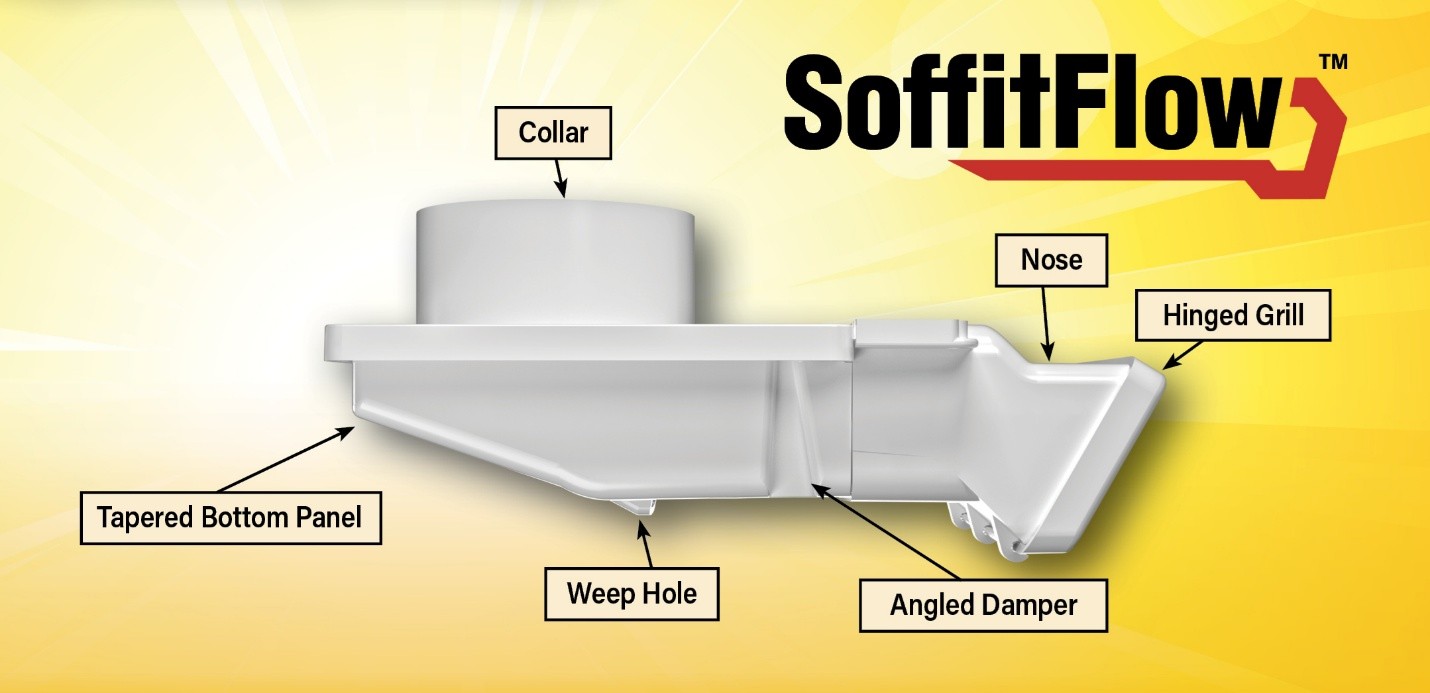The finished underside of the roof's overhang, or soffit, not only provides a clean aesthetic finish to the home, it plays a key role in attic ventilation. Varying types of homes and regions require different construction materials to accommodate the climate, each with its own advantages.
Venting from a bathroom fan to the home's exterior requires a vent specifically for that purpose. Soffit vents are installed under the soffit, connecting to the bathroom exhaust's ductwork and creating an effective exhaust for the bathroom's hot and humid air.
SoffitFlow's advanced design features make it the smart choice for safer, reliable bathroom venting, extending beyond the edge of the roofline to drive the hot, humid air away from the home. The SoffitFlow design functions in the same way as a car's tailpipe — exhausting hazardous fumes past the edge of the vehicle, preventing fumes from reentering.
SoffitFlow helps prevent dangerous attic mold by moving the warm, wet air past the edge of the fascia, the trim at the edge of the roof. When installed correctly, the patented design helps prevents humid, exhausted air from reentering the attic space and creating a breeding ground for white mold, black mold and algae. SoffitFlow’s streamlined design integrates standard soffit setups for a clean, finished look giving the homewoner the benefit of premium performance and peace of mind.

Aluminum Soffit:
Durable, low maintenance and usually resistant to rust and corrosion, making it the ideal choice for humid or coastal areas.
Vinyl Soffit:
Lightweight, fade-resistant, easy to maintain and cost effective. Less durable than aluminum, especially in harsh weather conditions.
Hardboard (Hardie Board) Soffit:
A fiber-cement panel that offers fire resistance and durability.
Durable, low maintenance and usually resistant to rust and corrosion, making it the ideal choice for humid or coastal areas.
Vinyl Soffit:
Lightweight, fade-resistant, easy to maintain and cost effective. Less durable than aluminum, especially in harsh weather conditions.
Hardboard (Hardie Board) Soffit:
A fiber-cement panel that offers fire resistance and durability.
Wood Soffit:
Natural and requires more upkeep. Prone to wood rot, warping and insect damage. Requires continual sanding and painting for longevity.
Soffit Vents
A vent that is installed in a soffit is referred to as a soffit vent and is designed to circulate air in the attic by allowing hot air to escape, maintaining temperature control. This movement of air is crucial in helping to prevent moisture and mold in the attic.
Natural and requires more upkeep. Prone to wood rot, warping and insect damage. Requires continual sanding and painting for longevity.
Soffit Vents
A vent that is installed in a soffit is referred to as a soffit vent and is designed to circulate air in the attic by allowing hot air to escape, maintaining temperature control. This movement of air is crucial in helping to prevent moisture and mold in the attic.
Venting from a bathroom fan to the home's exterior requires a vent specifically for that purpose. Soffit vents are installed under the soffit, connecting to the bathroom exhaust's ductwork and creating an effective exhaust for the bathroom's hot and humid air.
Introducing SoffitFlowTM
Not all vents are designed the same; most soffit vents direct the airflow down by design, allowing the warm, humid air to travel up, back into the attic space. Problems arise from the warm air creating condensation, leading to perfect conditions for mold spores to grow and thrive.SoffitFlow's advanced design features make it the smart choice for safer, reliable bathroom venting, extending beyond the edge of the roofline to drive the hot, humid air away from the home. The SoffitFlow design functions in the same way as a car's tailpipe — exhausting hazardous fumes past the edge of the vehicle, preventing fumes from reentering.
SoffitFlow helps prevent dangerous attic mold by moving the warm, wet air past the edge of the fascia, the trim at the edge of the roof. When installed correctly, the patented design helps prevents humid, exhausted air from reentering the attic space and creating a breeding ground for white mold, black mold and algae. SoffitFlow’s streamlined design integrates standard soffit setups for a clean, finished look giving the homewoner the benefit of premium performance and peace of mind.




